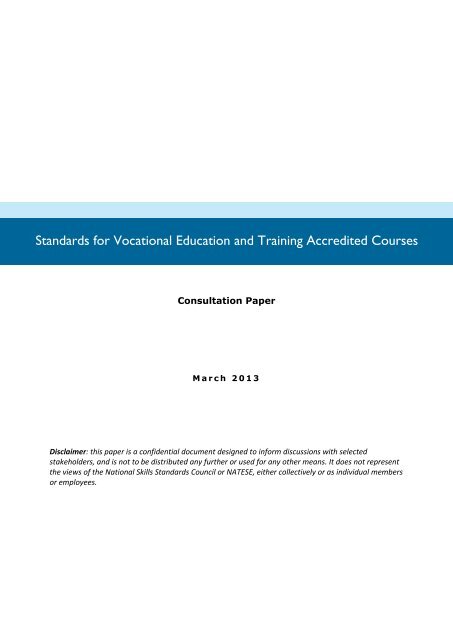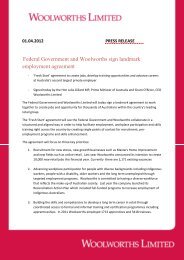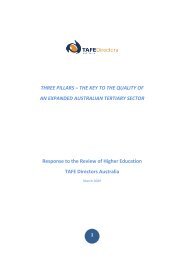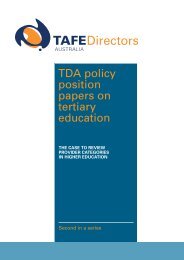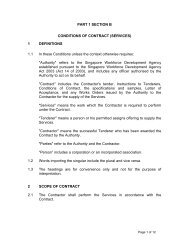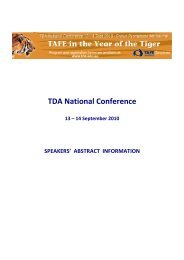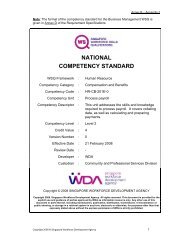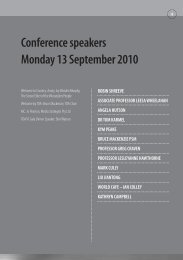Standards for Vocational Education and Training Accredited Courses
Standards for Vocational Education and Training Accredited Courses
Standards for Vocational Education and Training Accredited Courses
Create successful ePaper yourself
Turn your PDF publications into a flip-book with our unique Google optimized e-Paper software.
<strong>St<strong>and</strong>ards</strong> <strong>for</strong> <strong>Vocational</strong> <strong>Education</strong> <strong>and</strong> <strong>Training</strong> <strong>Accredited</strong> <strong>Courses</strong>Consultation PaperM a r c h 2 0 1 3Disclaimer: this paper is a confidential document designed to in<strong>for</strong>m discussions with selectedstakeholders, <strong>and</strong> is not to be distributed any further or used <strong>for</strong> any other means. It does not representthe views of the National Skills <strong>St<strong>and</strong>ards</strong> Council or NATESE, either collectively or as individual membersor employees.
1. Introduction <strong>and</strong> PurposeOverviewThe National Skills <strong>St<strong>and</strong>ards</strong> Council (NSSC) has developed <strong>St<strong>and</strong>ards</strong> <strong>for</strong> <strong>Training</strong> Packages thatwere endorsed by the COAG St<strong>and</strong>ing Council on Tertiary <strong>Education</strong>, Skills <strong>and</strong> Employment(SCOTESE) on 16 November 2012 <strong>for</strong> immediate implementation. 1 These st<strong>and</strong>ards were aculmination of a number of years of collaborative work to ensure that the agreed recommendationsfrom the COAG VET Products <strong>for</strong> the 21st Century Report 2 (endorsed by Ministers in 2009) werereflected in a new organising framework.As a consequence, <strong>St<strong>and</strong>ards</strong> <strong>for</strong> VET <strong>Accredited</strong> <strong>Courses</strong> now need to be updated to reflectrecommendations from the COAG VET Products <strong>for</strong> the 21st Century Report <strong>and</strong> the new organisingframework of <strong>St<strong>and</strong>ards</strong> <strong>for</strong> <strong>Training</strong> Packages to synchronise the design <strong>and</strong> development ofnationally recognised training products.The development of <strong>St<strong>and</strong>ards</strong> <strong>for</strong> <strong>Training</strong> Packages <strong>and</strong> <strong>St<strong>and</strong>ards</strong> <strong>for</strong> VET <strong>Accredited</strong> <strong>Courses</strong> wereout of scope <strong>for</strong> the broader review of the st<strong>and</strong>ards <strong>for</strong> the regulation of VET undertaken by theNSSC. Both of these st<strong>and</strong>ards specify the design of nationally recognised training products 3 asdistinct from st<strong>and</strong>ards <strong>for</strong> RTOs <strong>and</strong> VET regulators.Purpose of the consultation paperThis paper is designed to seek written feedback regarding draft <strong>St<strong>and</strong>ards</strong> <strong>for</strong> VET <strong>Accredited</strong><strong>Courses</strong> developed by the NSSC, <strong>and</strong> potential transition arrangements <strong>and</strong> implementationimplications.Feedback to the paper will ultimately enable the NSSC to appropriately consider the draft <strong>St<strong>and</strong>ards</strong><strong>for</strong> VET <strong>Accredited</strong> <strong>Courses</strong> in context of the <strong>St<strong>and</strong>ards</strong> <strong>for</strong> <strong>Training</strong> Packages.How do I respond?Please provide any feedback or comment by no later than 5pm on Wednesday, 3 April 2013.Feedback should be addressed to Luke Behncke, Director, Office of the NSSC, <strong>and</strong> provided via anyof the following ways:By email:luke.behncke@natese.gov.auBy fax: (03) 6216 0359Please contact Luke Behncke on (03) 9954 2601 if you have any questions or queries.1 Please refer to http://www.nssc.natese.gov.au/training_packages <strong>for</strong> further in<strong>for</strong>mation.2 Please refer to http://www.nssc.natese.gov.au/21c <strong>for</strong> further in<strong>for</strong>mation.3 According to training.gov.au (February 2013) there are 1,593 accredited courses (containing 2,278 accredited course units/modules)currently available. This compares to 1,699 qualifications, 908 skill sets <strong>and</strong> 17,957 units of competency currently available within 68<strong>Training</strong> Packages.
2. Background<strong>St<strong>and</strong>ards</strong> <strong>for</strong> <strong>Training</strong> PackagesOn 16 November 2012, SCOTESE endorsed new <strong>St<strong>and</strong>ards</strong> <strong>for</strong> <strong>Training</strong> Packages (see Appendix B) <strong>for</strong>immediate implementation with a three year transition period (see diagram 1 below).The design <strong>and</strong> development specifications <strong>for</strong> <strong>Training</strong> Packages contained within the existing<strong>Training</strong> Package Development H<strong>and</strong>book (TPDH) have now been superseded by the <strong>St<strong>and</strong>ards</strong> <strong>for</strong><strong>Training</strong> Packages.Diagram 1 – Transition <strong>for</strong> the new <strong>St<strong>and</strong>ards</strong> <strong>for</strong> <strong>Training</strong> Packages endorsed by SCOTESE on 16 November 2012.<strong>St<strong>and</strong>ards</strong> <strong>for</strong> the design of accredited courses in VETVET accredited courses address skill requirements <strong>for</strong> industry, enterprises <strong>and</strong> the communitywhere these are not covered in nationally endorsed <strong>Training</strong> Packages. They have the capacity toaddress changes in skill needs <strong>and</strong> the needs of emerging <strong>and</strong> converging industries <strong>and</strong> industrysectors in a responsive manner.Once a VET course has been accredited, the VET Regulator registers the course on the NationalRegister <strong>and</strong> can become available 4 <strong>for</strong> use by registered training organisations.The design of VET accredited courses that lead to an Australian Qualifications Frameworkqualification or statement of attainment is required to meet either the NVR <strong>St<strong>and</strong>ards</strong> <strong>for</strong> VET<strong>Accredited</strong> <strong>Courses</strong> or the AQTF 2007 <strong>St<strong>and</strong>ards</strong> <strong>for</strong> <strong>Accredited</strong> <strong>Courses</strong>. 54 Availability is dependent on copyright licensing in place by the course owner.5 Refer to http://www.nssc.natese.gov.au/vet_st<strong>and</strong>ards/st<strong>and</strong>ards_<strong>for</strong>_accredited_courses <strong>for</strong> further in<strong>for</strong>mation.3 | P a g e
The NVR <strong>St<strong>and</strong>ards</strong> <strong>for</strong> VET <strong>Accredited</strong> <strong>Courses</strong> are based on the AQTF 2007 <strong>St<strong>and</strong>ards</strong> <strong>for</strong> <strong>Accredited</strong><strong>Courses</strong>. The AQTF 2007 <strong>St<strong>and</strong>ards</strong> <strong>for</strong> <strong>Accredited</strong> <strong>Courses</strong> have not been revised since theirimplementation in 2007.Depending on the VET Regulator, either the AQTF <strong>St<strong>and</strong>ards</strong> <strong>for</strong> State <strong>and</strong> Territory CourseAccrediting Bodies or the SNR <strong>St<strong>and</strong>ards</strong> <strong>for</strong> VET Regulators (Part 3 – <strong>St<strong>and</strong>ards</strong> <strong>for</strong> accreditingcourses) are used <strong>for</strong> the purposes of accrediting courses. 6 These st<strong>and</strong>ards are included as part ofthe broader review of the st<strong>and</strong>ards <strong>for</strong> the regulation of VET being undertaken by the NSSC as theydirectly relate to the functions of VET regulators.As a consequence of the re<strong>for</strong>ms initiated by the COAG VET Products <strong>for</strong> the 21st Century Reportthat led to the recent endorsement of the <strong>St<strong>and</strong>ards</strong> <strong>for</strong> <strong>Training</strong> Packages, VET accredited coursest<strong>and</strong>ards now need to be updated to ensure that the design <strong>and</strong> development of nationallyrecognised training products (<strong>Training</strong> Packages <strong>and</strong> VET <strong>Accredited</strong> <strong>Courses</strong>) is synchronised withina consistent organising framework. 76 Refer to http://www.nssc.natese.gov.au/vet_st<strong>and</strong>ards/st<strong>and</strong>ards_<strong>for</strong>_vet_regulators <strong>for</strong> further in<strong>for</strong>mation.7 Note that outcomes as a result of consultation regarding the NSSC’s Position Paper may result in amendments being made to the<strong>St<strong>and</strong>ards</strong> <strong>for</strong> <strong>Training</strong> Packages, <strong>and</strong> subsequently VET accredited course st<strong>and</strong>ards.4 | P a g e
3. Draft <strong>St<strong>and</strong>ards</strong> <strong>for</strong> VET <strong>Accredited</strong> <strong>Courses</strong>At their 28 February 2013 meeting, the NSSC agreed to draft <strong>St<strong>and</strong>ards</strong> <strong>for</strong> VET <strong>Accredited</strong> <strong>Courses</strong>at Appendix A being used as the basis <strong>for</strong> stakeholder consultation.The development of the draft st<strong>and</strong>ards is consistent with the recommendations from the COAG VETProducts <strong>for</strong> the 21st Century Report that, among other things, between <strong>Training</strong> Packages <strong>and</strong> VET<strong>Accredited</strong> <strong>Courses</strong> there should be a consistent organising framework, maximum portability of unitsof competency <strong>and</strong> reduced duplication.Ultimately, the outcome of the development work <strong>for</strong> new <strong>St<strong>and</strong>ards</strong> <strong>for</strong> VET <strong>Accredited</strong> <strong>Courses</strong> willbe one set of design st<strong>and</strong>ards applying to all accredited courses, no matter whom it is regulated by.DesignThe draft st<strong>and</strong>ards continue to support VET accredited courses to responsively address skillrequirements <strong>for</strong> industry, enterprises <strong>and</strong> the community where these are not covered in nationallyendorsed <strong>Training</strong> Packages. However, they also continue to recognise <strong>and</strong> strengthen the role of<strong>Training</strong> Packages within the national training system. This is reflected in draft St<strong>and</strong>ard 3 where VET<strong>Accredited</strong> <strong>Courses</strong> must comply with <strong>St<strong>and</strong>ards</strong> 4 <strong>and</strong> 5 (units of competency), <strong>St<strong>and</strong>ards</strong> 6 <strong>and</strong> 7(Assessment Requirements) <strong>and</strong> St<strong>and</strong>ard 8 (Qualifications) of the <strong>St<strong>and</strong>ards</strong> <strong>for</strong> <strong>Training</strong> Packages.The previous st<strong>and</strong>ard within the NVR <strong>and</strong> AQTF VET accredited course st<strong>and</strong>ards associated withrestricting the duplication between VET <strong>Accredited</strong> <strong>Courses</strong> <strong>and</strong> <strong>Training</strong> Packages has beenstrengthened. Draft St<strong>and</strong>ard 2: A VET <strong>Accredited</strong> Course must not duplicate, by code, title orcoverage, the outcomes of an endorsed <strong>Training</strong> Package qualification, skill set or unit of competencyensures that code nomenclature <strong>and</strong> skill sets are now included.Consistent organising frameworkCompliance against specific st<strong>and</strong>ards within the <strong>St<strong>and</strong>ards</strong> <strong>for</strong> <strong>Training</strong> Packages in draft St<strong>and</strong>ard 3ensures a consistent <strong>and</strong> articulated organising framework between <strong>Training</strong> Packages <strong>and</strong> VET<strong>Accredited</strong> <strong>Courses</strong>. It supports portability of training products between <strong>Training</strong> Packages <strong>and</strong><strong>Accredited</strong> <strong>Courses</strong> <strong>for</strong> the purposes of work<strong>for</strong>ce development.Reference to specific st<strong>and</strong>ards in the <strong>St<strong>and</strong>ards</strong> <strong>for</strong> <strong>Training</strong> Packages also allows a streamlined <strong>and</strong>synchronised approach to the maintenance of the draft <strong>St<strong>and</strong>ards</strong> <strong>for</strong> VET <strong>Accredited</strong> <strong>Courses</strong>, inthat, any relevant, future revisions to the <strong>St<strong>and</strong>ards</strong> <strong>for</strong> <strong>Training</strong> Packages automatically take effectwithin the VET <strong>Accredited</strong> Course st<strong>and</strong>ards.Course need <strong>and</strong> in<strong>for</strong>mationDraft St<strong>and</strong>ard 1: A VET <strong>Accredited</strong> Course must be based on a demonstrated need <strong>for</strong> a nationallyrecognised vocational, education <strong>and</strong> training outcome provides a clear st<strong>and</strong>ard <strong>for</strong> development<strong>and</strong> design processes to meet. Draft St<strong>and</strong>ard 4: A VET <strong>Accredited</strong> Course complies with the VET<strong>Accredited</strong> Course Template ensures that course classification <strong>and</strong> in<strong>for</strong>mation con<strong>for</strong>ms to aconsistent structure <strong>for</strong> the purposes of accreditation.Transition <strong>and</strong> implementationIt is important to ensure that the transition <strong>and</strong> implementation of the draft <strong>St<strong>and</strong>ards</strong> <strong>for</strong> VET<strong>Accredited</strong> <strong>Courses</strong> synchronise as effectively as possible with the <strong>St<strong>and</strong>ards</strong> <strong>for</strong> <strong>Training</strong> Packagesbecause of their common design <strong>and</strong> inter-relationship.It is proposed that, on endorsement by Ministers, VET Regulators are able to immediatelyimplement the <strong>St<strong>and</strong>ards</strong> <strong>for</strong> VET <strong>Accredited</strong> <strong>Courses</strong> <strong>and</strong> all VET <strong>Accredited</strong> <strong>Courses</strong> meet the new<strong>St<strong>and</strong>ards</strong> <strong>for</strong> VET <strong>Accredited</strong> <strong>Courses</strong> within three years.5 | P a g e
4. QuestionsBelow are a number of key questions where the NSSC would appreciate stakeholder views.However, these questions should not be seen as definitive or exhaustive <strong>and</strong> additional commentsare most welcome.Question 1: Is the design of the draft <strong>St<strong>and</strong>ards</strong> <strong>for</strong> VET <strong>Accredited</strong> <strong>Courses</strong> consistent with therecommendations of the COAG VET Products <strong>for</strong> the 21st Century Report <strong>and</strong> the<strong>St<strong>and</strong>ards</strong> <strong>for</strong> <strong>Training</strong> Packages? If not, how could the design be improved?Question 2: Is the transition period of three years post endorsement of Ministers appropriate <strong>for</strong> allVET <strong>Accredited</strong> <strong>Courses</strong> to meet the draft <strong>St<strong>and</strong>ards</strong> <strong>for</strong> VET <strong>Accredited</strong> <strong>Courses</strong>?Question 3: What are the potential implementation implications of the draft <strong>St<strong>and</strong>ards</strong> <strong>for</strong> VET<strong>Accredited</strong> <strong>Courses</strong> <strong>for</strong> your organisation?6 | P a g e
Appendix ADraft <strong>St<strong>and</strong>ards</strong> <strong>for</strong><strong>Vocational</strong> <strong>Education</strong> <strong>and</strong><strong>Training</strong> <strong>Accredited</strong><strong>Courses</strong>Purpose of the <strong>St<strong>and</strong>ards</strong>The purpose of the <strong>St<strong>and</strong>ards</strong> <strong>for</strong> <strong>Vocational</strong> <strong>Education</strong> <strong>and</strong> <strong>Training</strong> (VET) <strong>Accredited</strong> <strong>Courses</strong> is toensure that VET accredited courses are of high quality <strong>and</strong> meet the work<strong>for</strong>ce development needs ofindustry, enterprises <strong>and</strong> individuals.National recognition <strong>and</strong> accreditationVET accredited courses address skill requirements <strong>for</strong> industry, enterprises <strong>and</strong> the community wherethese are not covered in nationally endorsed <strong>Training</strong> Packages. They have the capacity to addresschanges in skill needs <strong>and</strong> the needs of emerging <strong>and</strong> converging industries <strong>and</strong> industry sectors in aresponsive manner. Once a VET course has been accredited, the VET Regulator registers the course onthe National Register.The <strong>St<strong>and</strong>ards</strong> <strong>for</strong> VET <strong>Accredited</strong> <strong>Courses</strong> apply to the design <strong>and</strong> development of courses <strong>for</strong>accreditation consideration by a VET regulator. These are the course design st<strong>and</strong>ards that must be met<strong>for</strong> accreditation. The accreditation of a VET Course may be cancelled if these st<strong>and</strong>ards cease to bemet.<strong>St<strong>and</strong>ards</strong> <strong>for</strong> VET <strong>Accredited</strong> <strong>Courses</strong>St<strong>and</strong>ard 1: A VET <strong>Accredited</strong> Course must be based on a demonstrated need <strong>for</strong> a nationallyrecognised vocational, education <strong>and</strong> training outcome.St<strong>and</strong>ard 2: A VET <strong>Accredited</strong> Course must not duplicate, by code, title or coverage, the outcomes of anendorsed <strong>Training</strong> Package qualification, skill set or unit of competency.St<strong>and</strong>ard 3: A VET <strong>Accredited</strong> Course complies with <strong>St<strong>and</strong>ards</strong> 4, 5, 6, 7 <strong>and</strong> 8 of the <strong>St<strong>and</strong>ards</strong> <strong>for</strong><strong>Training</strong> Packages.St<strong>and</strong>ard 4: A VET <strong>Accredited</strong> Course complies with the VET <strong>Accredited</strong> Course Template.Draft <strong>St<strong>and</strong>ards</strong> <strong>for</strong> VET <strong>Accredited</strong> <strong>Courses</strong> 7
Appendix AVET <strong>Accredited</strong> Course TemplateCopyright <strong>and</strong> course classification in<strong>for</strong>mationCOPYRIGHT OWNERM<strong>and</strong>atory fieldCOPYRIGHTACKNOWLEDGEMENTM<strong>and</strong>atory fieldLICENSING AND FRANCHISEM<strong>and</strong>atory fieldAVETMISS INFORMATIONM<strong>and</strong>atory fieldProvide the name of the legal entity who owns copyright of thecourse(s) being submitted <strong>for</strong> accreditation.Ensure copyright approval <strong>for</strong> any units of competency not ownedby your organisation.Provide details of any copyright restrictions related to the course.Specify if this VET course may be used under licence or franchise<strong>and</strong> state requirements <strong>for</strong> use by other parties. Provide contactdetails <strong>for</strong> these arrangements.Where no arrangements exist insert:No licensing or franchising arrangements apply to this course at thetime of accreditation.Provide AVETMISS classification codes that describe the industry,occupational group <strong>and</strong> field of education <strong>for</strong> which the course isintended.ANZSCO (Australian <strong>and</strong> NewZeal<strong>and</strong> St<strong>and</strong>ard Classification ofOccupations)ASCED (Australian St<strong>and</strong>ardClassification of <strong>Education</strong>) code –4 digits (Field of <strong>Education</strong>)National course codeInsert code <strong>and</strong> descriptionInsert code <strong>and</strong> descriptionTo be provided by the VETRegulator once the course isaccredited[Classification codes <strong>for</strong> AVETMISS data may be found on the NCVERwebsite at www.ncver.edu.au]PERIOD OF ACCREDITATIONVET Regulator use onlyAccreditation dates will be entered by the VET Regulator if thecourse is accredited.Draft <strong>St<strong>and</strong>ards</strong> <strong>for</strong> VET <strong>Accredited</strong> <strong>Courses</strong> 8
Appendix ACourse in<strong>for</strong>mationCODEM<strong>and</strong>atory fieldTITLEM<strong>and</strong>atory fieldDESCRIPTIONM<strong>and</strong>atory fieldENTRYREQUIREMENTSOptional fieldPACKAGING RULESM<strong>and</strong>atory fieldMAPPINGINFORMATIONM<strong>and</strong>atory fieldCREDITARRANGEMENTSM<strong>and</strong>atory fieldThe code contains the three alpha characters relating to the course outcomes;followed by either (i) a numeric character identifying the AQF level, or (ii) thenumeric character ‘0’ identifying that the course outcome does not have thebreadth <strong>and</strong> depth required <strong>for</strong> a qualification; a two numeric sequenceidentifier; <strong>and</strong> two numeric characters identifying the year the course wasaccredited. It must comply with the length specified in the AVETMIS St<strong>and</strong>ard.A unique title that reflects the course outcomes. It must comply with thelength specified in the AVETMIS St<strong>and</strong>ard (no more than 100 characters).A description of the intended purpose commensurate with the courseoutcomes is required. In<strong>for</strong>mation must include target audience, <strong>and</strong>vocational <strong>and</strong>/or educational outcomes.Any licensing, legislative, regulatory or certification considerations. Wherenone exist insert:No licensing, legislative or certification requirements apply to thisqualification at the time of publication.Specifies any m<strong>and</strong>atory entry requirements.Specifies the number of core <strong>and</strong> elective units.Specifies the total number of units of competency required to achieve thequalification/statement of attainment.Lists all core <strong>and</strong> elective unit codes <strong>and</strong> titles, including prerequisite unitswhere they apply.Specifies code <strong>and</strong> title of any equivalent course, if appropriate.If no equivalent insert:No equivalent course.Specifies existing credit arrangements between the course <strong>and</strong> other VETaccredited courses, <strong>Training</strong> Package qualifications or Higher <strong>Education</strong>qualifications in accordance with the Australian Qualifications Framework.Where there are no direct credit arrangements in place the followingstatement is inserted here:At the time of accreditation of this course no national credit arrangementsexistDraft <strong>St<strong>and</strong>ards</strong> <strong>for</strong> VET <strong>Accredited</strong> <strong>Courses</strong> 9
Appendix AIMPLEMENTATIONINFORMATIONM<strong>and</strong>atory field‣ In<strong>for</strong>mation on the key features of the course <strong>and</strong> the industry that willimpact on the selection of training pathways.‣ In<strong>for</strong>mation relating to validation of any qualifications against the AQFspecifications <strong>for</strong> that qualification type.‣ Pathways advice.‣ Access <strong>and</strong> equity considerations.‣ Foundation Skills.‣ Advice on any health <strong>and</strong> safety implications in the industry.‣ Resource <strong>and</strong> equipment lists relevant to the course‣ Legal considerations <strong>for</strong> learners in the workplace/on placements.‣ Learning strategies guidance, describing the diversity of learners <strong>and</strong>learning strategies.‣ Knowledge guidance, identifying contextual in<strong>for</strong>mation such asknowledge requirements <strong>and</strong> resources.‣ Assessment strategies, providing guidance on implementation ofassessment requirements.‣ Other in<strong>for</strong>mation relevant to implementation of the course.UNITS OFCOMPETENCY LISTM<strong>and</strong>atory fieldList the code <strong>and</strong> title <strong>for</strong> each imported unit of competency <strong>and</strong>/or thecontent of new units of competency.Draft <strong>St<strong>and</strong>ards</strong> <strong>for</strong> VET <strong>Accredited</strong> <strong>Courses</strong> 10
Appendix B<strong>St<strong>and</strong>ards</strong> <strong>for</strong> <strong>Training</strong>PackagesThis document is one of three products that <strong>for</strong>m the organising framework of st<strong>and</strong>ards that support thedevelopment of industry <strong>Training</strong> Packages.The <strong>St<strong>and</strong>ards</strong> <strong>for</strong> <strong>Training</strong> Packages were endorsed by the St<strong>and</strong>ing Council on Tertiary <strong>Education</strong>, Skills <strong>and</strong>Employment on 16 November 2012.The <strong>St<strong>and</strong>ards</strong> <strong>for</strong> <strong>Training</strong> Packages <strong>and</strong> their underpinning policies can be found on the NSSC website:www.nssc.natese.gov.au/training_packagesThe organising framework of st<strong>and</strong>ards includes:NSSC - <strong>St<strong>and</strong>ards</strong> <strong>for</strong> <strong>Training</strong> PackagesNSSC - <strong>Training</strong> Package Products PolicyNSSC - <strong>Training</strong> Packages Development <strong>and</strong> Endorsement Process PolicyVersion: 1.0© 2012 Commonwealth of AustraliaWith the exception of the NATESE <strong>and</strong> NSSC Logos, any material protected by a trademark <strong>and</strong> where otherwisenoted, all material presented in this document is provided under a Creative Commons Attribution 3.0 Australialicense: http://creativecommons.org/licenses/by/3.0/au/The details of the relevant license conditions are available on the Creative Commons website as is the full legalcode <strong>for</strong> the CC BY 3.0 AU license: http://creativecommons.org/licenses/by/3.0/au/legalcodeThe document must be attributed as the NSSC - <strong>St<strong>and</strong>ards</strong> <strong>for</strong> <strong>Training</strong> Packages.<strong>St<strong>and</strong>ards</strong> <strong>for</strong> <strong>Training</strong> Packages 11
Appendix BPurpose of the <strong>St<strong>and</strong>ards</strong>The purpose of the <strong>St<strong>and</strong>ards</strong> <strong>for</strong> <strong>Training</strong> Packages is to ensure <strong>Training</strong> Packages are of high quality<strong>and</strong> meet the work<strong>for</strong>ce development needs of industry, enterprises <strong>and</strong> individuals.The <strong>St<strong>and</strong>ards</strong> <strong>for</strong> <strong>Training</strong> Packages apply to the design <strong>and</strong> development of <strong>Training</strong> Packages <strong>for</strong>endorsement consideration by the National Skills <strong>St<strong>and</strong>ards</strong> Council (NSSC).<strong>Training</strong> Packages – productsSt<strong>and</strong>ard 1:<strong>Training</strong> Packages consist of the following:1. NSSC endorsed components: units of competency; assessment requirements (associated with each unit of competency); qualifications; <strong>and</strong> credit arrangements.2. One or more quality assured companion volumes.<strong>Training</strong> Packages – policySt<strong>and</strong>ard 2:St<strong>and</strong>ard 3:<strong>Training</strong> Package developers comply with the NSSC <strong>Training</strong> Package Products Policy.<strong>Training</strong> Package developers comply with the NSSC <strong>Training</strong> Package Development<strong>and</strong> Endorsement Process Policy.<strong>St<strong>and</strong>ards</strong> <strong>for</strong> <strong>Training</strong> Packages 12
Appendix B<strong>Training</strong> Packages – componentsUnits of CompetencySt<strong>and</strong>ard 4: Units of competency specify the st<strong>and</strong>ards of per<strong>for</strong>mance required in the workplace.St<strong>and</strong>ard 5:The structure of units of competency complies with the unit of competencytemplate.Assessment RequirementsSt<strong>and</strong>ard 6:St<strong>and</strong>ard 7:Assessment requirements specify the evidence <strong>and</strong> required conditions <strong>for</strong>assessment.Every unit of competency has associated assessment requirements. The structure ofassessment requirements complies with the assessment requirements template.QualificationsSt<strong>and</strong>ard 8:St<strong>and</strong>ard 9:Qualifications comply with the Australian Qualifications Framework specification <strong>for</strong>that qualification type.The structure of the in<strong>for</strong>mation <strong>for</strong> the Australian Qualifications Frameworkqualification complies with the qualification template.Credit ArrangementsSt<strong>and</strong>ard 10:Credit arrangements existing between <strong>Training</strong> Package qualifications <strong>and</strong> Higher<strong>Education</strong> qualifications are listed in a <strong>for</strong>mat that complies with the creditarrangements template.Companion VolumesSt<strong>and</strong>ard 11:St<strong>and</strong>ard 12:A quality assured companion volume implementation guide produced by the <strong>Training</strong>Package developer is available at the time of endorsement <strong>and</strong> complies with thecompanion volume implementation guide template.<strong>Training</strong> Package developers produce other quality assured companion volumes tomeet the needs of their stakeholders as required.<strong>St<strong>and</strong>ards</strong> <strong>for</strong> <strong>Training</strong> Packages 13
Appendix BUnit of Competency TemplateUNIT CODEM<strong>and</strong>atory fieldUNIT TITLEM<strong>and</strong>atory fieldAPPLICATIONM<strong>and</strong>atory fieldThe unit code contains the three alpha characters identifying the<strong>Training</strong> Package, followed by alpha <strong>and</strong>/or numeric characters. Itmust comply with the length specified in the AVETMIS St<strong>and</strong>ard(no more than 12 characters).The title concisely describes the unit outcome.It must comply with the length specified in the AVETMIS St<strong>and</strong>ard(no more than 100 characters)The application section briefly describes how the unit is practicallyapplied in the industry <strong>and</strong> in what context(s) the unit may beapplied. It Includes:a summary statement of unit content;focused, useful in<strong>for</strong>mation on how <strong>and</strong> where the unit ofcompetency could be practically applied <strong>and</strong> who mightuse it; <strong>and</strong>the unit of competency’s relationship to any licensing,legislative, regulatory or certification requirements.Where no requirements exist, insert:No licensing, legislative or certification requirementsapply to this unit at the time of publication.PREREQUISITE UNITOptional fieldCOMPETENCY FIELDOptional fieldUNIT SECTOROptional fieldList any unit(s) in which the c<strong>and</strong>idate must be deemedcompetent prior to the determination of competency in this unit.Used only when the <strong>Training</strong> Package developer wishes tocategorise a set of units within a <strong>Training</strong> Package in relation to atype of work.Used only when the <strong>Training</strong> Package developer wishes tocategorise a set of units within a <strong>Training</strong> Package in relation to anindustry sector.ELEMENTSM<strong>and</strong>atory fieldElements describe the essentialoutcomes.PERFORMANCE CRITERIAM<strong>and</strong>atory fieldPer<strong>for</strong>mance criteria describe the per<strong>for</strong>mance needed todemonstrate achievement of the element.<strong>St<strong>and</strong>ards</strong> <strong>for</strong> <strong>Training</strong> Packages 14
Appendix B1. Elements describe actionsor outcomes that aredemonstrable <strong>and</strong>assessable.1.1 Per<strong>for</strong>mance criteria clearly relate to the element.1.2 They are expressed as a st<strong>and</strong>ard.1.3 They specify the required per<strong>for</strong>mance in relevant tasks,roles, <strong>and</strong> skills.1.4 They reflect the applied knowledge that enables competentper<strong>for</strong>mance.FOUNDATION SKILLSM<strong>and</strong>atory fieldThis section describes those language, literacy, numeracy <strong>and</strong> employment skills that are essential toper<strong>for</strong>mance.Foundation skills essential to per<strong>for</strong>mance in this unit, but not explicit in the per<strong>for</strong>mance criteriaare listed here, along with a brief context statement.Where all foundation skills essential to per<strong>for</strong>mance in this unit are explicit in the per<strong>for</strong>mancecriteria insert:Foundation skills essential to per<strong>for</strong>mance are explicit in the per<strong>for</strong>mance criteria ofthis unit of competency.RANGE OF CONDITIONSOptional fieldSpecifies different work environments <strong>and</strong> conditions that may affect per<strong>for</strong>mance. Essentialoperating conditions that may be present (depending on the work situation, needs of the c<strong>and</strong>idate,accessibility of the item, <strong>and</strong> local industry <strong>and</strong> regional contexts) are included.Range is restricted to essential operating conditions <strong>and</strong> any other variables essential to the workenvironment.UNIT MAPPING INFORMATIONM<strong>and</strong>atory fieldSpecifies code <strong>and</strong> title of any equivalent unit of competency.If no equivalent insert:No equivalent unit.LINKSM<strong>and</strong>atory fieldLink to Companion Volume Implementation Guide.<strong>St<strong>and</strong>ards</strong> <strong>for</strong> <strong>Training</strong> Packages 15
Appendix BAssessment Requirements TemplateTITLEM<strong>and</strong>atory fieldAssessment Requirements <strong>for</strong> [insert Unit of CompetencyCode <strong>and</strong> Title]PERFORMANCE EVIDENCEM<strong>and</strong>atory fieldKNOWLEDGE EVIDENCEM<strong>and</strong>atory fieldASSESSMENT CONDITIONSM<strong>and</strong>atory fieldspecifies the required product <strong>and</strong> process evidence.specifies the frequency <strong>and</strong>/or volume ofproduct/process evidence.specifies the relationship between the product <strong>and</strong>process evidence <strong>and</strong> the per<strong>for</strong>mance criteria.specifies what the individual must know in order to safely<strong>and</strong> effectively per<strong>for</strong>m the work task described in the unitof competency.relates directly to the per<strong>for</strong>mance criteria <strong>and</strong>/or range ofconditions.indicates the type <strong>and</strong> depth of knowledge required tomeet the dem<strong>and</strong>s of the unit of competency.stipulates any m<strong>and</strong>atory conditions <strong>for</strong> assessment.specifies the conditions under which evidence <strong>for</strong>assessment must be gathered, including any details ofequipment <strong>and</strong> materials, contingencies, specifications,physical conditions, relationships with team members <strong>and</strong>supervisor, relationship with client/customer, <strong>and</strong>timeframe.specifies assessor requirements, including any detailsrelated to qualifications, experience <strong>and</strong> industry currency.LINKSM<strong>and</strong>atory fieldLink to Companion Volume Implementation Guide.<strong>St<strong>and</strong>ards</strong> <strong>for</strong> <strong>Training</strong> Packages 16
Appendix BQualification TemplateQUALIFICATION CODEM<strong>and</strong>atory fieldQUALIFICATION TITLEM<strong>and</strong>atory fieldQUALIFICATION DESCRIPTIONM<strong>and</strong>atory fieldENTRY REQUIREMENTSOptional fieldPACKAGING RULESM<strong>and</strong>atory fieldQUALIFICATION MAPPINGINFORMATIONM<strong>and</strong>atory fieldLINKSM<strong>and</strong>atory fieldThe qualification code contains the three alpha charactersidentifying the <strong>Training</strong> Package, a numeric character identifyingthe AQF level, a two numeric character sequence identifier, <strong>and</strong>two numeric characters identifying the year the qualification wasendorsed. It must comply with the length specified in theAVETMIS St<strong>and</strong>ard.A unique title that reflects the qualification outcome. It mustcomply with the length specified in the AVETMIS St<strong>and</strong>ard (nomore than 100 characters).A description of the qualification outcomes.Any licensing, legislative, regulatory or certificationconsiderations. Where none exist insert:No licensing, legislative or certificationrequirements apply to this qualification at thetime of publication.Specifies any m<strong>and</strong>atory entry requirementsSpecifies the total number of units of competency required toachieve the qualification.Specifies the number of core <strong>and</strong> elective units.Lists all core <strong>and</strong> elective unit codes <strong>and</strong> titles, includingprerequisite units where they apply.Specifies code <strong>and</strong> title of any equivalent qualification.If no equivalent insert:No equivalent qualification.Link to Companion Volume Implementation Guide.<strong>St<strong>and</strong>ards</strong> <strong>for</strong> <strong>Training</strong> Packages 17
Appendix BCredit Arrangements TemplateCREDIT ARRANGEMENTS FOR [insert <strong>Training</strong> Package Code <strong>and</strong> Title]M<strong>and</strong>atory fieldQUALIFICATION CODEM<strong>and</strong>atory fieldQUALIFICATION TITLEM<strong>and</strong>atory fieldCREDIT ARRANGEMENT DETAILSM<strong>and</strong>atory fieldSpecifies existing credit arrangements between<strong>Training</strong> Package qualifications <strong>and</strong> Higher<strong>Education</strong> qualifications in accordance with theAQF.Where there are no direct credit arrangementsin place the following statement is insertedhere:At the time of endorsement of this<strong>Training</strong> Package no national creditarrangements exist.LINKSM<strong>and</strong>atory fieldLink to Companion Volume Implementation Guide.<strong>St<strong>and</strong>ards</strong> <strong>for</strong> <strong>Training</strong> Packages 18
Appendix BCompanion Volume Implementation Guide TemplateCOMPANION VOLUME IMPLEMENTATION GUIDE FOR (insert <strong>Training</strong> Package Code <strong>and</strong> Title)M<strong>and</strong>atory fieldOVERVIEWINFORMATIONM<strong>and</strong>atory fieldIMPLEMENTATIONINFORMATIONM<strong>and</strong>atory fieldVersion control <strong>and</strong> modification history.List of AQF qualifications, Skill Sets <strong>and</strong> units of competencyin the <strong>Training</strong> Package.Unit mapping in<strong>for</strong>mation, including equivalence tablelinking old to new units of competency.Qualification mapping in<strong>for</strong>mation, including equivalencetable linking old to new qualification.List of imported <strong>and</strong> prerequisite units in the <strong>Training</strong> Package.Key work <strong>and</strong> training requirements in the industry.Regulation <strong>and</strong> licensing implications <strong>for</strong> implementation.In<strong>for</strong>mation on the key features of the <strong>Training</strong> Package <strong>and</strong> theindustry that will impact on the selection of training pathways.Industry sectors <strong>and</strong> occupational outcomes of qualifications.Explanation of any m<strong>and</strong>atory entry requirements <strong>for</strong>qualifications.Pathways advice, particularly in line with requirements of the AQFPathways Policy.Access <strong>and</strong> equity considerations.Foundation Skills.Advice on any health <strong>and</strong> safety implications in the industry.Resource <strong>and</strong> equipment lists relevant to the <strong>Training</strong> Package.Legal considerations <strong>for</strong> learners in the workplace/on placements.Other in<strong>for</strong>mation relevant to implementation of the <strong>Training</strong>Package.<strong>St<strong>and</strong>ards</strong> <strong>for</strong> <strong>Training</strong> Packages 19
Appendix BLINKSOptional fieldResources supporting the companion volume implementationguide.Other companion volumes as required including:oooLearning strategies guidance, describing the diversity oflearners <strong>and</strong> learning strategies.Knowledge guidance, identifying contextual in<strong>for</strong>mationsuch as knowledge requirements <strong>and</strong> resources.Assessment strategies, providing guidance onimplementation of assessment requirements.<strong>Training</strong> Package developer’s quality assurance process <strong>for</strong>companion volumes.<strong>St<strong>and</strong>ards</strong> <strong>for</strong> <strong>Training</strong> Packages 20


